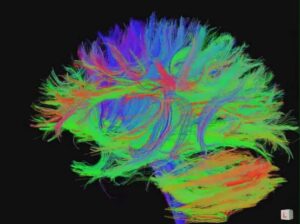“Periventricular leukomalacia” (PVL) which literally means, “softening of the white matter around the ventricles”, is a typical type of brain injury encountered in preterm newborns. The name of the disease comes from the 1962 work by Banker and Larroche – two very respectable anatomopathologists, expert in perinatal neurology. PVL is characterized by the more or less extensive necrosis (i.e. destruction) of the white matter (important tissue consisting of glial cells and nerve fibers) around the cerebral ventricles.
Leukomalacia: who is affected?
PVL is an injury typically associated with prematurity which mainly affects infants born between 26-27 and 32 weeks of gestational age. Very rarely it can affect preterm infants of the higher gestational age of 32-34 weeks.
How common is it?
Recent epidemiological studies show a general downward trend in the incidence of PVL in recent decades.
The more severe cystic form of PVL which is characterized by the significant cavitation of the white matter easily observable by ultrasound and MRI, strikes less than 5% of infants with birth weight lower than 1500 grams. Less severe form of PVL, characterized by the single or multiple very small almost microscopic areas of necrosis, is more frequent. These minor injuries cannot be observed by ultrasound while MRI can detect the signs of other anomalies, for example the so-called “punctate lesions”. These anomalies can affect more than 10% of infants having a birth weight lower than 1500 grams.
What are the causes?
The mechanisms leading to the periventricular leukomalacia are still not fully understood. They are complex and not limited to the generic ischemia – insufficient blood supply also partly caused by the immaturity of autoregulation of cerebral blood flow mechanisms. Generic ischemia used to be considered an adequate and sufficient explanation. Today, we believe that it is caused by the inflammation, which starts immediately after the birth, in cells called intrauterine pre-oligodendrocytes. These cerebral white matter cells regulate the development of white matter. They are extremely vulnerable to ischemia and inflammation – phenomena that are often part of the perinatal history, occurring before, during or after childbirth of these fragile infants.
When it appears?
The lesions usually appear during the weeks following the birth but always before the initially expected due date, i.e. before 40 weeks of gestational age. Within few weeks the damage stops spreading and injuries stabilize becoming permanent scars.
How is it treated?
There is no specific therapy to repair the damage of the white matter caused by periventricular leukomalacia. However, it is essential to follow-up these infants over time in order to promptly identify the potential necessity for rehabilitation, such as physiotherapy. The latter is of paramount importance in order to allow the patient to minimize the impact of the injury on the neurological functions thus by exploiting the capacity of the central nervous system to compensate (neuro plasticity).
What problems can it cause to the future of the newborn?
A diagnosis of periventricular leukomalacia increases the risk of neurological problems, in particular in the motor functions. This is especially the case when the cavities can be seen either by the ultrasound or by the MRI. These injuries can show us how extensive the damage was. The most typical damage is a motor deficit in the lower limbs, known as spastic diplegia (since 1862 called “Little’s disease” after Dr. William J. Little who was the first to define these motor difficulties in the preterm newborns). The deficit can be of varying degrees: from mild, with autonomous walking capacity possible – to severe, requiring aids such as a wheelchair. In some cases, the motor function of the upper limbs is also affected. Much less frequent, but still possible, are cognitive deficits and visual disturbances. These disorders can usually be detected 6-9 months after the due date. Although, at times, some signs can already be seen by medical professionals at the corrected age of 3 months.





